Rosacea impacts the skin on your face, but did you know that it can also impact your eyes? Over half of people with rosacea will experience eye symptoms and may be diagnosed with ocular rosacea—a subtype of rosacea that leads to inflammation of the eyes. Ocular rosacea is often mild, but if left untreated it can worsen and potentially lead to scarring and vision loss. People with rosacea are also at higher risk of developing glaucoma and in rare cases may develop severe corneal disease. Here’s what you need to know about rosacea and eye health so you can get the care you need.
How does rosacea affect your eyes?
If you’re wondering, “Does rosacea cause eye problems?,” the answer is that it certainly can. Researchers aren’t entirely sure why rosacea impacts the eyes in addition to the skin, but the immune system, vascular system, and microorganisms that are part of the skin microbiome likely all play a role. When rosacea impacts the eyes, they can become dry, itchy, and red with visible blood vessels. If you’re experiencing eye symptoms, it’s important to see an ophthalmologist right away to receive an accurate diagnosis and discuss treatment options.
What is ocular rosacea?
Ocular rosacea is an inflammatory condition that impacts the eyes. Most people with ocular rosacea also have cutaneous rosacea, although some people may develop eye symptoms before they develop skin symptoms. Other people with ocular rosacea may not experience any skin symptoms at all. Skin symptom severity doesn’t determine eye symptom severity.
Symptoms of ocular rosacea include:
- Swollen eyelids
- Discoloration around the eyes
- Visible blood vessels in the whites of the eyes
- Watery eyes
- Dry eyes
- Itchy eyes
- Blurred vision
- Feeling like there’s something in your eye
- Recurrent styes or pink eye
- Eyelash loss
Common eye conditions that can occur as part of ocular rosacea include:
What to do about ocular rosacea
If left untreated, ocular rosacea can worsen and lead to vision problems. That’s why it’s important to see an ophthalmologist if you’re experiencing eye symptoms. If you have cutaneous rosacea, getting regular eye screenings can help you monitor and address any eye symptoms that may arise. If you don’t have an ophthalmologist, your dermatologist or primary care provider can make a referral.
Your ophthalmologist may recommend warm compresses, artificial tears, eyelid scrubs, or consuming omega-3 fatty acid supplements. They may prescribe eye drops or antibiotics or recommend intense pulsed light (IPL) therapy. Talk to your ophthalmologist to determine a treatment plan that’s best for you.
Prone to facial redness? Consider Gladskin
The skin microbiome can play a role in facial redness. Gladskin's Rosacear Cream is a lightweight moisturizer that contains Staphefekt®, our patented enzyme that restores balance to the skin microbiome. Learn more.









